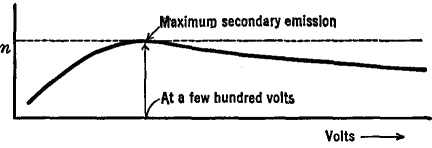| Basic Radio is a free introductory textbook on electronics based on tubes. See the editorial for more information.... |

|

Home  Electronic Devices Electronic Devices  Diodes Diodes  Secondary Emission Secondary Emission |
||||
| See also: Some Electron Multiplier Tubes | ||||






|
||||
|
Secondary EmissionAuthor: J.B. Hoag Consider next what happens when streams of high-speed electrons strike a metal plate. If the energy is sufficient, new electrons are actually knocked out of the metal plate. These are called secondary electrons and the process is called secondary emission. In fact, the number of secondary electrons ejected by the oncoming electrons is frequently greater than the number of incident electrons. This does not mean that we get something for nothing, for the energies of the secondary electrons total to an amount less than the energy of the incident electrons. As the speed of the primary or incident electrons is increased from zero to a few hundred volts, the number of secondaries per primary increases from a low value, near zero, to a maximum. With further increase beyond this value of a few hundred volts energy of the primaries, the number of secondaries slowly decreases, as indicated in Fig. 10 F.
Actually the curve just mentioned is not smooth but has very small humps and dips in it. Secondary electrons leave the surface at random in all directions, at velocities corresponding to only a few volts, even when 1,000-volt primary electrons are used. Insulators, such as glass, will also give off secondary electrons. In these cases, and with high-velocity primary electrons, as used with large transmitting, rectifying, and X-ray tubes, the number of secondaries per primary may be somewhat greater than unity. In these cases, with the negatively charged electrons leaving the surface in larger numbers than the number of incident charges, the insulator will acquire a positive instead of a negative charge. At another point in the same high-voltage tube, the number of secondaries per primary may be less than unity and a negative surface charge accumulates. With the continued increase in opposite charges between the two points, sufficient electrical strains may be set up so as to break down the insulator and destroy the tube. Later, we shall see how the phenomenon of secondary emission has been put to good use.
|
||||
Home  Electronic Devices Electronic Devices  Diodes Diodes  Secondary Emission Secondary Emission |
||||
Last Update: 2009-11-01


